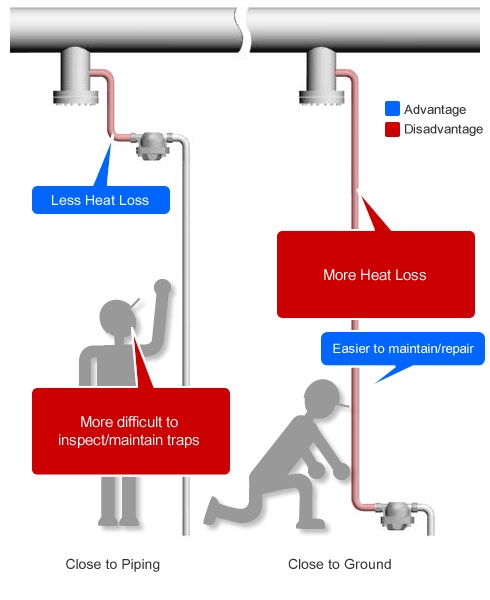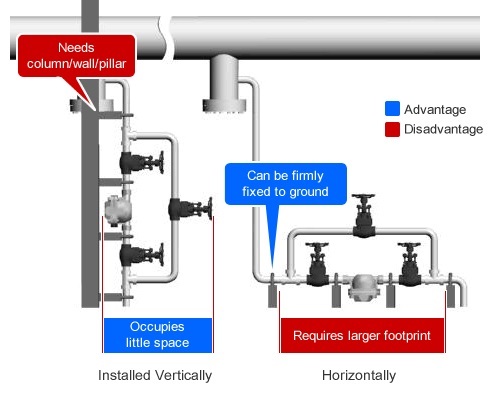Contents:
1. Position of steam traps: close to the pipeline or close to the ground?
2. Other points for attention
3. Installation direction of steam trap: vertical or horizontal?
4. Other points for attention
1. Position of the steam trap: close to the pipeline or close to the ground?
Do you want to know the best installation position of the steam trap of the steam main pipe? The inlet pipe of the steam trap is actually an extension of the steam main pipe. From the point of view of reducing heat radiation, the best way is to install the steam trap close to the main pipe.
However, the steam main pipe is usually erected at a higher position. If the steam trap is installed close to the main pipe, it will bring difficulties to maintenance and inspection. It's easy for us to ignore and forget these traps in remote locations. Once these traps run into problems, we may leave them in a state of failure within several years.
If there is a ladder or other facilities near the installation position of the steam trap to climb high, these conditions may be improved. However, without these facilities, we recommend installing the steam trap at a convenient location. In addition, if the steam trap is installed horizontally, it is recommended that the pipe connecting the steam trap and the collecting well be as short as possible, so as to reduce the heat radiation loss.

Close to the pipeline:
Advantages: thermal radiation loss
Disadvantages: It brings difficulties to the inspection and maintenance of steam traps, which may lead to the long-term failure of these forgotten steam traps.
Close to the ground:
Advantages: convenient maintenance and repair
Disadvantages: As an extension of the steam main pipe, the longer the downward vertical pipe means the more heat radiation loss (On the premise of not affecting the operation of the steam trap, thermal radiation loss can be reduced by installing thermal insulation).
Pay attention to other points:
When choosing a steam trap for the steam main pipe, we strongly recommends the use of a steam trap with continuous drainage characteristics, such as the free-floating ball type. If the size of the collecting well is appropriate, other types of steam traps, such as disc type, inverted bucket type, or pressure balance thermo-static type, can also be used when the condensed water can't reach the main pipe. It is not recommended for supervisors to use the bimetallic trap, because this type of trap is likely to lead to condensate accumulation inside supervisors. Especially when the steam trap is installed near the pipeline, this situation will be more serious.
2. Installation direction of steam trap: vertical or horizontal?
Condensate water is collected from overhead steam pipelines by collecting wells. If affected by the spatial layout, the pipes from the collecting wells can be directly connected to a steam trap. The configuration required for vertical installation and horizontal installation is the same, for example, stop valves need to be installed in front of and behind the steam trap, and bypass should be set, so installation near the ground means that more area is needed.
On the other hand, if the steam trap is installed vertically, it needs enough support, such as a pipe rack, to support the steam trap and other pipes. In addition, if the steam traps are not firmly fixed on the ground, maintenance and repair will be more difficult, so we need to set up vertical supports and fix them on the ground.
When the steam trap is located close to the ground, there is no need to install additional supports, because the ground can provide sufficient support for the steam trap station. And because they are easily accessible, the repair and maintenance are relatively convenient. Each installation method has its own advantages and disadvantages, so please choose the appropriate type according to your actual situation on site.

Vertical installation:
Advantages: small installation space
Disadvantages: Pipe column/wall/rack needs to be installed. The vertical installation will make maintenance difficult.
Horizontal installation:
Advantages: can be firmly fixed on the ground
Disadvantages: Installation takes up more area.
Pay attention to other points:
When selecting some types of traps, such as free float traps, it is necessary to confirm that different types of traps may have different installation methods. Some types are installed horizontally and some are installed vertically.
